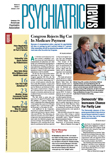Children and adolescents are exposed to more than 3,000 advertising messages every day urging them to consume food, medicines, alcohol, or tobacco. The American Academy of Pediatrics (AAP) says this media onslaught leads to poor nutrition, obesity, smoking, and drinking among young people and wants to do something about it.
The AAP has issued a policy statement, its first on the subject in 11 years, calling for some restrictions on advertising and urging parents and educators to do more to counter its potential outcomes.
“I'd like to see parents more sensitized to the effects of media on their children and cut their time in front of the screen,” said Victor Strasburger, M.D., chief of the Division of Adolescent Medicine and a professor of pediatrics and of family and community medicine at the University of New Mexico School of Medicine, at a news conference to announce the statement. Strasburger was the lead author of a paper in the December Pediatrics setting out the statement and the AAP's recommendations.
“The AAP is trying to educate pediatricians and parents on this issue,” he said. “It just makes sense to limit exposure to unhealthy forms of advertising.”
Children should also be taught media literacy—that is, how and why ads and other forms of communication are made, he said. He would also like to see an end to tobacco advertising in all media and a restriction of alcohol advertising to “tombstone” ads, which contain only product images, not pictures of attractive women or funny talking lizards.
He also urged pediatricians to counsel young patients and their parents to limit noneducational screen time to no more than two hours a day and to work with community groups to ban school-based advertising of all kinds. Currently, for example, Channel One, a for-profit media company, offers 10 minutes of currentevents programming and two minutes of commercials in 12,000 schools each day. There is even school-bus radio, broadcasting music and ads to a captive audience on the way to and from school, he said.
Sex is another issue. Drug companies spend millions advertising erectile-dysfunction medications, while ads for birth-control products or emergency contraception are banned from the networks, Strasburger noted.
The AAP wants ads for erectile-dysfunction medications to be presented only after 10 p.m. Running these ads earlier in the evening, as is often the case, confuses children and makes sex look like a recreational sport, he said.
Were they available, ads promoting birth-control options might help reduce teen pregnancy rates without increasing teenage sexual activity, he said.
The AAP also criticized the beer and other alcohol commercials that run during sports broadcasts, which young people often watch. In prime time, one alcohol commercial appears every four hours but during sports events, that rate jumps to 2.4 commercials an hour.
Citing the current obesity epidemic, Strasburger argued that cutting advertising of fast food or junk food is simpler than putting 50 million children on a diet.
“Other countries do it,” he said. “There's no doubt in my mind that we'd have a healthier society if we restricted advertising.”
A recent Institute of Medicine report on food marketing to children and adolescents also called for the food, beverage, media, and entertainment industries to promote healthful diets for young people. However, the Institute of Medicine noted that the research base for nontelevision advertising was limited, with few carefully designed studies. Most of the studies that have been published examine television watching in general but not specifically advertising and its effects.
The AAP is calling for more research and is urging Congress to convene a task force of representatives from the medical and public health communities, as well as from the food, toy, and advertising industries, to discuss the problem and propose solutions.
